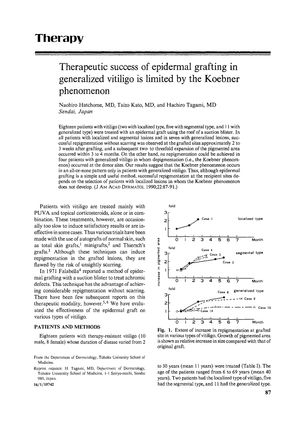Therapeutic Success of Epidermal Grafting in Generalized Vitiligo Is Limited by the Koebner Phenomenon
January 1990
in “
Journal of The American Academy of Dermatology
”

TLDR Skin grafting can help repigment vitiligo, but it's less effective for widespread cases due to the Koebner phenomenon.
In a 1990 study involving 18 patients with therapy-resistant vitiligo, epidermal grafting was performed using the roof of a suction blister. The study included 2 patients with localized vitiligo, 5 with segmental vitiligo, and 11 with generalized vitiligo. All patients with localized and segmental vitiligo, as well as 7 patients with generalized vitiligo, experienced successful repigmentation without scarring within 2 to 3 weeks post-grafting, with the pigmented area expanding two to threefold over 3 to 4 months. However, 4 patients with generalized vitiligo saw no repigmentation due to the Koebner phenomenon at the donor sites. The study concluded that while epidermal grafting can be effective for vitiligo, its success in generalized vitiligo is compromised by the Koebner phenomenon, making patient selection critical, with those having localized lesions and no Koebner phenomenon being the best candidates for this treatment.


